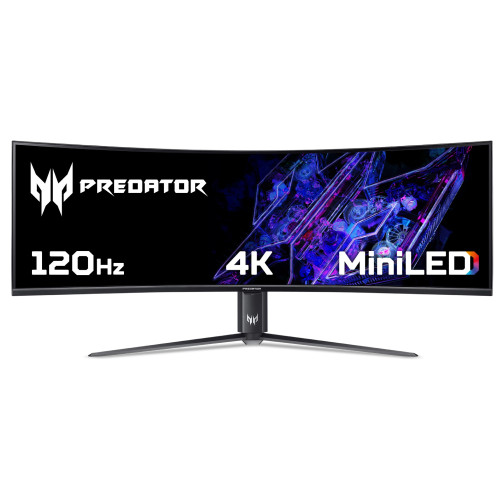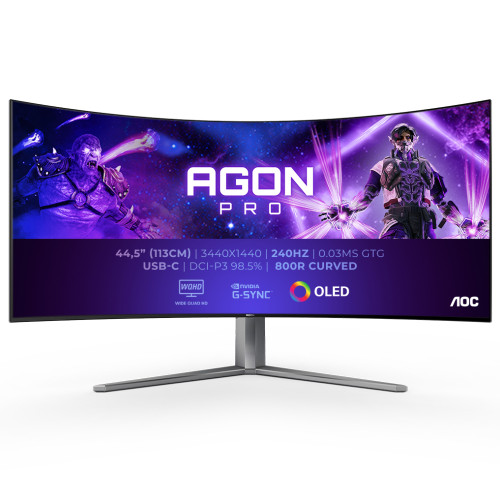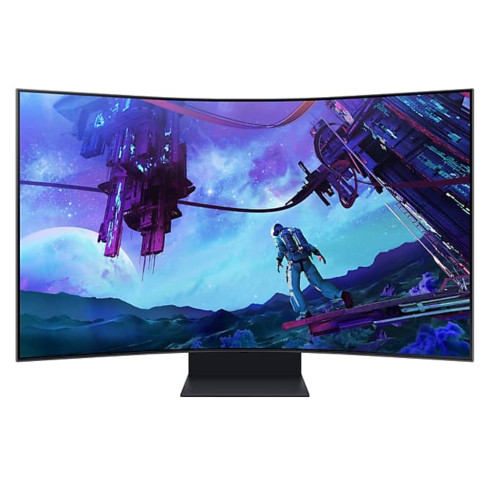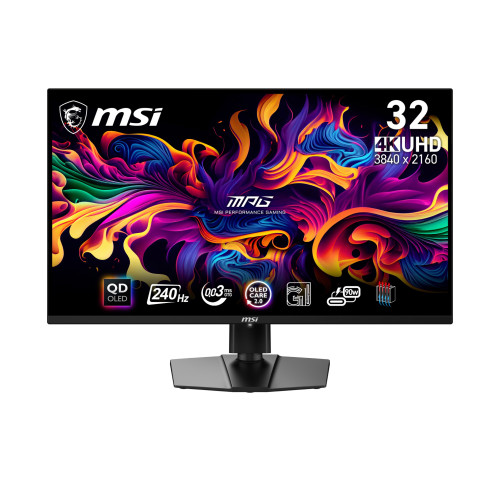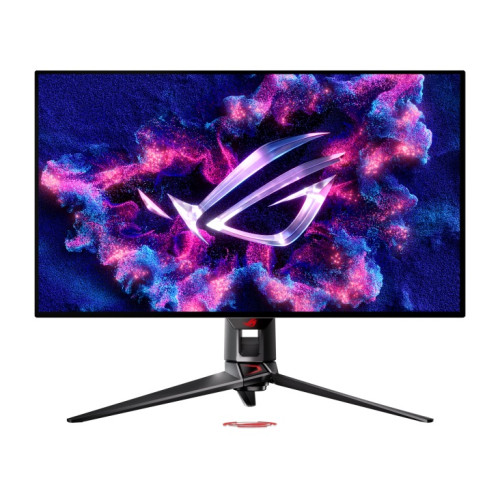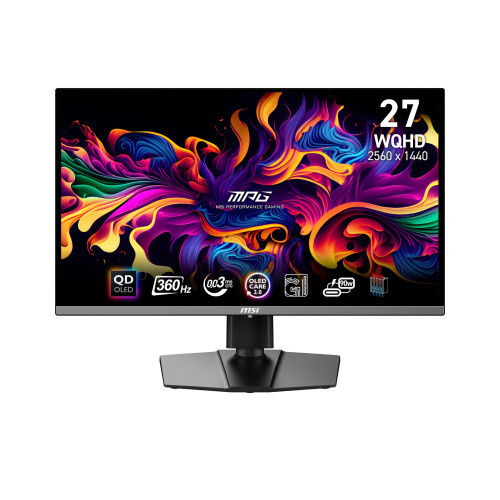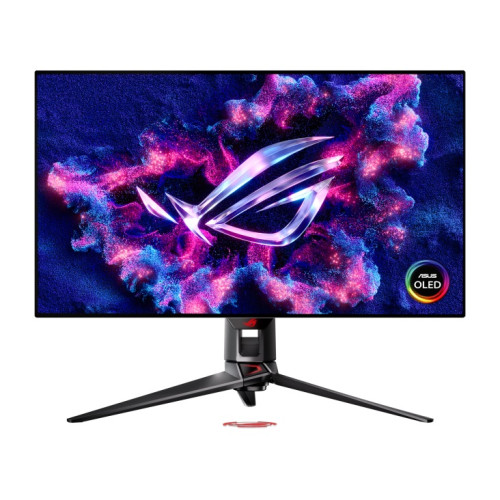POSTED: 11 April, 2025
Monitors for RTX 50 Series: Maximise Your Performance with the Perfect Display
Your GPU is only half the battle—unlock the true power of the RTX 50 Series with a monitor that’s built to keep up! Find out about the best monitors for RTX 50 Series in this blog!
Welcome to the future of PC gaming and performance computing. With the arrival of the RTX 50 Series GPUs, NVIDIA has once again raised the bar for what’s possible in gaming, content creation, and AI-powered workflows. Blazing-fast ray tracing, revolutionary DLSS 4.0, and jaw-dropping frame rates are just the beginning. But there’s one critical element that often gets overlooked—your monitor.
Pairing the raw power of an RTX 50 Series graphics card with an outdated or underperforming display is like streaming 4K Netflix on dial-up—it defeats the point. You simply won’t experience the full force of what your GPU can do. Whether you're chasing 4K ultra settings, craving ultra-high refresh rates, or exploring the vibrant contrast of OLED panels, the right monitor is what transforms potential into performance.
That’s exactly what this article is here to help you with. We’re unlocking the best monitors for RTX 50 Series setups, exploring everything from 4K gaming monitors to OLED gaming monitors, and demystifying terms like 144Hz vs 240Hz vs 360Hz. Gamers, creators, and entertainment enthusiasts alike—this guide will help you unlock the full potential of your RTX 50 Series with the perfect display.
Why the Monitor Matters with the RTX 50 Series
The RTX 50 Series isn’t just another generational upgrade- it’s a leap forward in visual fidelity, responsiveness, and overall performance. With cutting-edge technologies like DLSS 4.0, AI-driven frame generation, and enhanced ray tracing, games have never looked sharper or run smoother. These GPUs deliver cinematic realism, lightning-fast frame rates, and unmatched fluidity, designed to push modern titles like Avowed and Myst beyond previous limits. But to truly experience that leap, your monitor must be capable of keeping up.
The Bottleneck Effect
Here’s the catch: even the most powerful RTX 50 Series GPU (RTX 5090, RTX 5080) can be held back by a display that can’t handle what it’s capable of outputting. This is what’s known as a bottleneck effect. If your monitor’s refresh rate is capped at 60Hz or its resolution doesn’t exceed Full HD, you’re not just missing out—you’re leaving performance on the table. Your GPU could be rendering 120, 240, or even 360 frames per second, but if your display can’t match that, all that power goes to waste. That’s why investing in high-performance monitors for RTX 50 Series is essential to unlock the full potential of your next-gen graphics card.
Unlocking the True Performance of the RTX 50 Series
To unlock the true performance of the RTX 50 Series, your monitor needs to complement its capabilities. Start with resolution. Higher-end GPUs are built for 4K gaming monitors or ultrawide QHD options, delivering crisp detail and broader fields of view. If you’re looking to maximise immersion, don’t overlook the ultrawide monitor benefits—a wider field of view can transform both gaming and productivity experiences. Then consider refresh rate. If you’re gaming competitively, a high refresh rate monitor (144Hz and beyond) provides that crucial edge in reaction time and motion clarity. Want ultra-smooth visuals? Then it’s time to explore 240Hz vs 360Hz or beyond displays. For those chasing the pinnacle of visual fidelity, consider why choose OLED monitors—they offer unparalleled contrast, perfect blacks, and lightning-fast response times. Ultimately, the right monitors for RTX 50 Series will ensure your next-gen GPU delivers everything it’s capable of and more.
Similarly, panel type also plays a role. OLED gaming monitors offer perfect blacks and vivid contrast, ideal for immersive, cinematic gaming, while IPS panels are excellent for colour accuracy and viewing angles. Response time is equally important; lower values (1ms or less) reduce ghosting and blur during fast-paced action.
In short, the RTX 50 Series is a beast, but only if your monitor lets it breathe. Choosing the right display isn’t just about better visuals, it’s about unlocking every ounce of performance, ensuring you see, feel, and react faster than ever. Your next-gen GPU deserves a next-gen screen to match.
Choosing the Best Monitor for the RTX 50 Series
One of the standout strengths of the RTX 50 Series is its ability to handle high resolutions with ease. Thanks to enhanced ray tracing cores, DLSS 4.0, and advanced AI frame generation, these GPUs are built to deliver blistering performance across 1440p, 4K, and even 8K gaming setups. However, regardless of if you’re chasing competitive edge or immersive realism, choosing the right resolution is key to maximising your experience.
Different Resolutions and Which One Stands Out for the RTX 50 Series
For most gamers, 1440p hits the sweet spot, sharper than Full HD, but less demanding than 4K, making it ideal for high refresh rate gameplay.
However, if you're after stunning detail, immersive worlds, and razor-sharp clarity, 4K gaming monitors are where the RTX 50 Series truly shines. With more than eight million pixels on-screen, 4K delivers cinematic visuals that make every texture, reflection, and lighting effect come alive, perfectly suited for the GPU’s advanced ray tracing capabilities.
Competitive gamers might prefer the lower latency and higher frame rates possible with 1440p or even 1080p, specifically when paired with a 240Hz or 360Hz monitor. But for those who prioritise rich, lifelike graphics, high resolution monitors like 4K and beyond are the clear choice.
Having said that, the RTX 50 Series is even capable of 8K gaming, though this is still niche, requiring very specific displays and setups. But the fact that it’s even possible is a testament to just how powerful these GPUs really are.
Ultimately, your ideal resolution depends on how you play. If you want buttery smooth motion for competitive shooters, 1440p with a high refresh rate might be your best match. But if you want jaw-dropping visuals that make the most of your investment, 4K gaming monitors offer the perfect canvas for the RTX 50 Series to flex its muscle.
Refresh Rates: 144Hz vs 240Hz vs 360Hz
Your RTX 50 Series is ready to deliver. Now it’s time to choose a monitor that’s ready to receive.
If you’ve invested in an RTX 50 Series GPU, you already expect next-level performance and that doesn’t stop at resolution.
One of the most impactful yet often overlooked aspects of your gaming experience is refresh rate.
A monitor refresh rate determines how many times per second the monitor refreshes the image on screen, measured in hertz (Hz). A higher refresh rate means smoother motion, sharper gameplay, and an undeniable competitive edge. This means when choosing a monitor for the RTX 50 Series, ensure it has a high refresh rate to help you reap all of these advantages.
Though for years, 60Hz was the standard, with the rise of high-performance GPUs like the RTX 50 Series, we’ve entered a new era of ultra-smooth gaming. Now, 144Hz vs 240Hz vs 360Hz is the real debate. So, which is right for you?
144Hz: The New Standard
For most gamers, a 144Hz monitor is a dramatic upgrade from 60Hz. The difference is instantly noticeable—motion becomes smoother, gameplay feels more responsive, and tearing is significantly reduced, specifically when paired with G-Sync or FreeSync. For titles like RPGs, casual shooters, and story-driven games, 144Hz hits the sweet spot between performance and value. The RTX 50 Series easily handles 144Hz at 1080p or even 1440p in most modern games, making it an ideal choice for mainstream gamers looking for a fluid and immersive experience.
240Hz: Competitive Sweet Spot
Stepping up to 240Hz offers even faster refresh cycles, great for competitive esports titles like CS2, Valorant, Apex Legends, and Fortnite. Every millisecond counts, and the difference in response time can be felt in faster aim, quicker movement, and improved reaction time. The RTX 50 Series is more than capable of delivering frame rates high enough to keep up with 240Hz, specifically at 1080p or finely tuned 1440p settings. If you’re serious about online competitive play, this is a fantastic middle ground.
360Hz: Peak Performance
Then there’s the elite tier: 360Hz. Built for professional esports athletes and perfectionists, these monitors are laser-focused on speed. The motion clarity is unmatched, and when paired with the RTX 50 Series’ insane frame rate potential, you’re experiencing gaming at its absolute fastest. While not essential for everyone, 360Hz gives you every possible advantage in fast-paced titles, shaving off precious milliseconds that could mean the difference between winning or losing.
In short, whichever refresh rate you choose, it should match your GPU’s output. But one thing’s for sure—if you want to unlock the full power of your RTX 50 Series, a high refresh rate monitor is absolutely essential. Keep reading to find out the best monitors for the RTX 50 Series!
OLED Gaming Monitors: Are They Worth It?
With the RTX 50 Series unlocking incredible detail, lighting effects, and frame rates, gamers are looking for displays that do justice to such raw power. Enter OLED gaming monitors—a rising favourite for those who crave the ultimate in visual quality and immersion. But are they really worth it?
Let’s start with the benefits. OLED technology doesn’t rely on a backlight like traditional LED panels. Instead, each pixel emits its own light, which means perfect blacks, infinite contrast ratios, and an image that feels almost lifelike. When combined with the real-time ray tracing and DLSS 4.0 capabilities of the RTX 50 Series, scenes become deeper, richer, and more immersive than ever.
But it’s not just about contrast. OLED gaming monitors also boast ultra-fast pixel response times, often below 1ms. That means motion blur is virtually non-existent, even in the fastest-paced games. Add to that stunning colour accuracy and wide viewing angles, and it’s easy to see why OLED is becoming the go-to for both gamers and content creators.
Of course, there are some considerations. Burn-in—where static elements like HUDs or logos leave a faint ghost image over time, is a known risk with OLED panels. However, modern OLED monitors come with built-in protections like pixel shifting and screen savers to minimise this. As long as you're using your monitor sensibly, the risk is fairly low for most users.
Lifespan has also improved significantly. Today’s OLEDs are designed to last tens of thousands of hours, which is more than enough for the average gamer or professional. If you’re worried, it’s always worth looking at warranty cover and manufacturer protections for added peace of mind.
For those who want their RTX 50 Series GPU to deliver the most stunning visuals possible, OLED is a strong contender. The contrast, clarity, and speed are simply in a league of their own.
Ultrawide and Super Ultrawide Monitors
When it comes to immersion, few displays can compete with the cinematic sweep of ultrawide and super ultrawide monitors. These expansive formats transform how you experience games, multitask, and even create content, making them the ultimate match for the performance of the RTX 50 Series.
An ultrawide monitor (typically 21:9) offers a wider field of view than standard 16:9 displays, wrapping your peripherals in rich, detailed visuals. Step up to super ultrawide (32:9), and you're essentially working (or gaming) with two screens in one, minus the bezels. Whatever you do, the added width makes everything feel more immersive and lifelike.
But ultrawide isn’t just about gaming. There’s a massive boost to productivity as well. With extra horizontal space, you can run multiple windows side-by-side without alt-tabbing or compromising on screen real estate. Creative professionals, coders, streamers, and multitaskers will appreciate the seamless workflow and extra room to breathe.
Now, here’s where the RTX 50 Series and the best monitors for RTX 50 Series are worth mentioning. Ultrawide and super ultrawide resolutions like 3440x1440 and 5120x1440 require serious GPU horsepower, particularly if you're aiming for high frame rates and graphical settings. Thanks to DLSS 4.0, ray tracing, and massive GPU bandwidth, the RTX 50 Series handles these resolutions effortlessly. The result? You can enjoy ultra-smooth gameplay across the entire widescreen expanse, without sacrificing visual quality or performance.
Pairing your powerful RTX 50 graphics card with an ultrawide monitor is more than a visual upgrade, it’s an experience enhancer. From increased immersion and multitasking ease to better overall performance, ultrawide displays unlock new ways to engage with your setup.
For gamers, creators, and power users alike, ultrawide and super ultrawide monitors aren’t just luxury, they’re a perfect companion for unleashing the full potential of your RTX 50 Series GPU.
Feature Checklist: What Else to Look For
To truly harness the power of your RTX 50 Series GPU, your display needs more than just the right resolution and refresh rate. The best monitors for RTX 50 Series combine cutting-edge specs with smart features that elevate your entire setup. For example, ultrawide monitor benefits go beyond immersion—they offer enhanced multitasking and a broader field of view, perfect for both gaming and productivity. If you’re aiming for stunning visuals, the top 4K gaming monitors for the RTX 50 Series deliver razor-sharp detail and if you’re chasing competitive advantage, high refresh rate monitors are unbeatable choices.
However, while resolution and refresh rate are critical when choosing monitors for the RTX 50 Series, there are other specs that matter too. If you want a summarised version of what else to look for in a monitor for the RTX 50 Series, here’s an essential checklist.
G-SYNC/FreeSync Support
A high-performance GPU deserves silky-smooth gameplay, and that’s where G-SYNC and FreeSync come in. These adaptive sync technologies prevent screen tearing and stuttering by synchronising your monitor’s refresh rate with your GPU’s frame output. The RTX 50 Series supports G-SYNC natively, so a G-SYNC compatible or FreeSync Premium monitor is highly recommended for a fluid, tear-free experience.
HDR Capability
With stunning real-time ray tracing and enhanced visual fidelity, HDR (High Dynamic Range) is a must-have. It brings brighter highlights, deeper blacks, and a wider colour range that makes games look more lifelike. Look for HDR400 as a minimum, though HDR600 or HDR1000 will give you a far more impactful viewing experience. Check out the Samsung Odyssey Neo N9 Gaming Monitor, an excellent HDR1000 monitor for powerful gaming!
Connectivity: HDMI 2.1 & DisplayPort 2.1
The RTX 50 Series supports cutting-edge connectivity standards, and your monitor should too. HDMI 2.1 and DisplayPort 2.1 provide the bandwidth necessary for high refresh rates at 4K and beyond, with full support for features like VRR (Variable Refresh Rate) and ALLM (Auto Low Latency Mode). These are essential for both current and future-proof performance.
Colour Gamut & Brightness
For creators and gamers alike, wide colour gamut coverage, such as 95–100% DCI-P3 or AdobeRGB, ensures accurate, vibrant colour reproduction. Pair that with a brightness level of at least 300–400 nits for strong HDR impact and visibility in well-lit rooms.
Eye-Care Technology
Long gaming or editing sessions can take a toll. Look for monitors with flicker-free technology, blue light filters, and ergonomic designs to protect your eyes and improve comfort over extended use.
Ideal Monitor Specs for the RTX 50 Series at a Glance:
- Resolution: 1440p or 4K (or ultrawide equivalents)
- Refresh Rate: 144Hz or higher
- Sync Tech: G-SYNC or FreeSync
- HDR: At least HDR400
- Ports: HDMI 2.1 / DisplayPort 2.1
- Panel: IPS or OLED preferred
- Colour Accuracy: Wide gamut, factory calibrated if possible
Top 5 Monitor Picks for the RTX 50 Series at Box.co.uk
Choosing the right monitor for your RTX 50 Series GPU doesn't have to be overwhelming. No matter if you're after pristine 4K visuals, lightning-fast refresh rates, or immersive ultrawide experiences, we've rounded up top options to suit every setup and budget. Each one is hand-picked to maximise your GPU’s performance and elevate your experience.
Best Cost-Effective 1440p Monitor:
AOC AGON Pro AG276QZD2 OLED Quad HD 240 Hz 0.03 ms Height Adjustable Built-in Speakers Gaming Monitor (MPN: AG276QZD2)
Where Power Meets Precision for Next-Gen Gaming
Push your NVIDIA 50 Series GPU to its full potential with the AOC AGON Pro AG276QZD2 – the ultimate cost-effective 1440p OLED monitor built for high-performance gaming. Its blistering 240Hz refresh rate and ultra-fast 0.03ms response time ensure ultra-smooth, tear-free action, while Adaptive Sync and NVIDIA G-SYNC compatibility deliver flawless frame pacing. Paired with a stunning QD-OLED 26.7-inch Quad HD display, it offers deep blacks, vivid colours, and breathtaking clarity. Experience precision, speed, and immersion without breaking the bank.
Best OLED Monitor for the RTX 5080:
MSI MPG 321URX QD-OLED 32" QD-OLED UHD 4K 240Hz 0.03ms USB-C Gaming Monitor (MPN: MPG 321URX QD-OLED)
Next-Level Visuals for Next-Gen Power
Unlock the full potential of your NVIDIA 50 Series GPU with the MSI MPG 321URX QD-OLED, a 32" 4K UHD powerhouse built for serious gamers and creators. Its Quantum Dot OLED panel delivers jaw-dropping colour, ultra-deep blacks, and pixel-perfect contrast with DisplayHDR True Black 400 certification. With an ultra-fast 240Hz refresh rate and ultra-low 0.03ms response time, every frame feels instant and fluid. HDMI 2.1, USB-C, and DisplayPort 1.4a ensure total compatibility with high-end setups, consoles, and productivity rigs. Overall, this monitor redefines what 4K performance should look like.
Best Monitor for the RTX 5090 Overall:
ASUS PG32UCDM ROG Swift 31.5" OLED 4K HDR 0.03ms USB-C 240Hz Nvidia G-SYNC Gaming Monitor (MPN: PG32UCDM)
Elite Visuals. Precision Perfected
Experience unmatched clarity and speed with the ASUS PG32UCDM ROG Swift, a 31.5" OLED 4K gaming monitor built for the next generation of performance. Powered by a 240Hz refresh rate, ultra-low 0.03ms response time, and NVIDIA G-SYNC, it pairs flawlessly with the NVIDIA 50 Series, delivering buttery-smooth, tear-free visuals. The OLED panel delivers deep blacks, true HDR brilliance, and pixel-perfect precision for elite-level gameplay and creative work. Designed for those who demand the best without compromise, this is undoubtedly one of the top monitors for the RTX 50 Series.
Best QHD Monitor for the RTX 5090:
MSI MPG 271QRX QD-OLED 27" QD-OLED QHD 360Hz 0.03ms USB-C Gaming Monitor (MPN: MPG 271QRX QD-OLED)
The Ultimate QHD Partner for RTX 5090 Power
Unleash the true potential of your RTX 5090 with the MSI MPG 271QRX QD-OLED, the ultimate 360Hz QHD gaming monitor engineered for elite performance. Its next-gen QD-OLED panel delivers razor-sharp 2560 x 1440 visuals, enhanced by DisplayHDR True Black 400 for deep contrast and vibrant colour. The lightning-fast 0.03ms response time and ultra-smooth 360Hz refresh rate offer an edge in every frame. With HDMI 2.1, VRR, and ALLM support, it’s ready for PC and console alike. Backed by OLED Care 2.0 and an ergonomic design, this monitor doesn’t just perform—it protects and impresses. A remarkable match for next-gen NVIDIA RTX 50 Series GPUs.
One of the Best 4K Monitors for the RTX 50 Series:
ASUS ROG Swift PG32UCDP 31.5" OLED 4K 240Hz USB-C Gaming Monitor (MPN: PG32UCDP)
Designed to Dominate
If you're pairing your build with an RTX 50 Series graphics card like the GIGABYTE AORUS GeForce RTX 5090 MASTER 32GB Graphics Card or ASUS GeForce RTX 5090 ROG Astral LC 32GB OC Gaming Graphics Card, the ASUS ROG Swift PG32UCDP stands out as one of the best 4K gaming monitors to match its performance. Featuring a vibrant 31.5" OLED panel, ultra-sharp 3840 x 2160 resolution, and an astonishing 240Hz refresh rate and a lightning-fast 0.03ms response time, it’s built to keep pace with the most demanding next-gen games. Whether you're chasing every competitive edge or revelling in cinematic single-player titles, this display ensures your RTX 50 Series GPU shines with excellent clarity and silky-smooth visuals. With HDMI, DisplayPort, and USB-C support, it's the future-proof choice for serious gamers.
Find these incredible monitors for the RTX 50 Series and many others at Box.co.uk. Learn more why you should buy your next RTX 50 Series monitor with us!
Conclusion
The RTX 50 Series pushes the limits of next-gen gaming power, delivering jaw-dropping visuals, lightning-fast frame rates, and unmatched realism thanks to DLSS 4.0, ray tracing, and advanced AI-enhanced rendering. But without the right monitor, much of that performance can go untapped.
4K precision, 360Hz fluidity, OLED immersion—whatever your gaming style, your display is key to unlocking the true potential of your RTX 50 Series GPU. Choosing the right monitor isn’t just a nice-to-have; it’s essential.
Though many robust monitors are available for the RTX 50 Series, for those who don’t want to spend time on research, we recommend exploring the following top five monitors for the RTX 50 Series at Box.co.uk: AOC AGON Pro AG276QZD2, MSI MPG 321URX, ASUS PG32UCDM ROG Swift, MSI MPG 271QRX, and ASUS ROG Swift PG32UCDP.
At Box.co.uk, we make it easy to find your perfect display. From budget-friendly picks to cutting-edge panels, our extensive range of high refresh rate monitors, ultrawides, OLEDs, and more is curated to suit every play style and budget. You can also visit our Monitor Buying Guide to get expert insights for finding an unrivalled monitor for your needs and budget.
Shopping at Box.co.uk means more than just a great selection. You’ll also enjoy fast delivery, flexible finance options, including PayPal Pay in 3, and expert advice to help you make the right choice. Whatever you’re looking for, we’ve got the monitor and the service to match your RTX 50 Series ambitions.
Monitors for RTX 50 Series are crafted for those who demand the best – buy your preferred one today at Box.co.uk!
